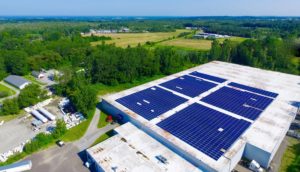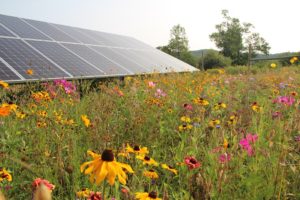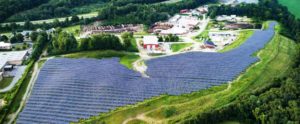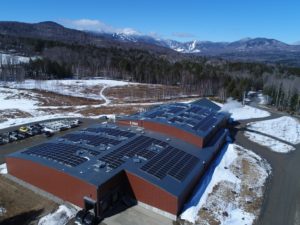This Guest Article for REVITALIZATION is by Chad Farrell.
When the silk mill in downtown Keene, New Hampshire was booming 100 years ago, it produced decorative yarns using leftovers from local textile factories.
Today it houses commercial tenants from light manufacturing to office and retail and also something rather unusual for a century-old building: an array of almost 400 solar panels generating energy on its rooftop.

The 140kWp solar array at the silk mill building in downtown Keene, NH, is just one of our many achievements in revitalizing older properties.
We have seen a lot of properties get renewed and rejuvenated this way, with an eye toward long-term energy savings via investments in renewable energy.
From Cabot Creamery Cooperative’s refrigerated warehouse in St. Albans, Vermont, to the South Burlington and Brattleboro landfills to the ECHO Leahy Center for Lake Champlain on the Burlington waterfront – all of these customers are learning about the benefits of going solar.
It’s worth it. Tousley Property Management, owner of the silk mill in Keene and its new solar project, will cut its energy costs by over $20,000 per year and lock in these long-term savings on electricity as a result of the array.
Also, over the next 25 years, the solar energy it generates will offset 2,375 metric tons of carbon dioxide, equal to the emissions from 5.8 million auto miles, and help the City of Keene meet its commitment to utilize 100% renewable electricity by 2030.
“This is an important project for our company that will allow us to minimize our annual electricity expenses while supporting statewide renewable energy initiatives,” said Toby Tousley, of Tousley Property Management, LLC.
We started as a real estate redevelopment firm back in 2007. Since our name change from Encore Redevelopment to Encore Renewable Energy in 2015, our focus on revitalizing underutilized properties has allowed us to lead the way in tapping a new market for solar development.
Turning brownfields to brightfields
The reuse of brownfields and landfills as host sites for larger solar arrays is a relatively recent phenomenon.
As solar markets have matured, there has been a significant pivot regarding the siting of solar projects, with an increased focus on previously developed, non-virgin land and increased recognition of the value of siting closer to where electricity is consumed.
So, instead of encouraging renewable energy development everywhere, the industry now needs forward-thinking policies that focus on where solar projects are best sited over the next several decades.
While brownfields and landfills can offer more preferable locations for solar arrays than typical greenfield land (from environmental, aesthetic, and grid quality standpoints), the nature of working on and around environmentally impaired soil and groundwater presents additional complexity and risk. As a result, the development and construction of these projects is generally more expensive than for similarly sized projects on previously undeveloped land.
Even with these added challenges, turning brownfields to brightfields still offers one of the best opportunities to develop more solar in areas with greater population densities. As an example, the 2.2-megawatt South Burlington, Vermont landfill solar project produces over 2,600,000 kWh of clean electricity per year in one of Vermont’s heavier load zones; that’s the equivalent of nearly 400 typical New England homes.
In signing onto a long-term contract, the City is also saving money on its municipal electrical costs, with projections for up to $5 million in savings over the 25-year contract period.These savings are being rolled into additional energy efficiency and renewable energy generation projects for the City, under a revolving loan fund construct. This project was possible due to a significant legislative effort championed by Encore to allow for larger scale net metering projects on closed landfills in Vermont.
Heather Riehle, Chair of South Burlington City Council, commented on the positive community impact of the project: “We are excited to be a leader in repurposing a closed landfill for the generation of renewable energy,” she said. “This otherwise unusable property will now provide savings, energy, and opportunity for our community. This project represents the type of public-private partnership that is so important to South Burlington’s continued development.”
The 5.7-megawatt array we installed last year on a Brattleboro, Vermont landfill is now generating nearly 7,000,000 kWh of clean electricity per year, $100,000 in annual lease revenue for the Windham County Solid Waste Management District, and significant savings on the electric bills for 20 schools, municipalities and other public institutions in the area – all through a group net metering arrangement. The total value to the community from this project is estimated to exceed $10 million over the 20-year contract term. It’s currently the largest landfill solar project in Vermont, and there will be more.
According to the U.S. Environmental Protection Agency, there are an estimated 450,000 brownfields in the United States. The National Renewable Energy Laboratory estimates that landfills and other contaminated sites cover 15 million acres across America, an estimated 80,000 of those acres of which have already been pre-screened for renewable energy development.
Developing solar on existing urban projects
Coming online in late 2018, the new solar carport at the ECHO Lake and Science Center is a great example of the additive value of solar to non-profit, community service and educational institutions.
Under the terms of our agreement with ECHO, Encore and our investor partner will own the array for six years, after which the institution will have the opportunity to purchase the asset at fair market value and thus garner the full benefits of the electrical production for the remainder of the life of the project (which could be 50 years or more), following the simple payback period.
Adding a solar array in a dense urban area like the Burlington waterfront required complex engineering and innovative technology. The project began as a new parking lot for the museum, incorporating solar required our team to design the array for varying lakefront levels, high winds, specific traffic patterns, and existing underground infrastructure. All of this is to say, it’s extremely important to be aware of how your property can incorporate a solar project.
This project was one of the first in the U.S to employ innovative bi-facial (two-sided) panels that capture reflected light as well as direct rays from the sun. This is an emerging technological trend that increases both output and ECHO’s electricity savings.
Can solar revitalize your property?

156kWp solar project represents both Burlington’s commitment to clean energy and our ability to successfully implement the best financial and engineering practices.
The path to adding a solar-powered facility to properties like an old silk mill, a museum or a landfill is one you may be considering traveling yourself, whether you are in pursuit of affordable electricity or to lower your carbon footprint.
There are some key factors to look into as you begin investigating whether solar can be a good reuse option for your property. One reason we’ve had such success with transforming underutilized land and property renewal is our attention to detail, and that’s why we encourage those potentially interested in embracing all that solar has to offer to proceed carefully before going solar.
For starters, it’s important to understand your local and regional electrical market. Unfortunately there are still 51 different U.S. solar markets, one for every state and another for Washington DC.
Are you located in a jurisdiction that supports the renewable energy marketplace, with the appropriate legislation, policies and regulations in place? How cumbersome might it be to secure all of the permits required to construct the project? There are resources out there such as the Database of State Incentives for Renewables & Efficiency to help identify and navigate these larger policy risks and potential policy impediments.
Second, it’s important to take a realistic look at your property to determine if it’s well suited for a solar array. Sun exposure and the status of your roof or open ground is integral to whether a solar project would be right for your property. Does it have good southern exposure? Are there tall buildings, hillsides or trees to the south, east or west that may shade the project? Taking an inventory of these specifics are crucial before moving forward.
Next, you’ll need to assess if and how your project will connect with the grid. Solar projects require interconnection agreements with the local distribution utility within which the project is located. Is there adequate capacity on the circuit that serves the property? Is there three-phase electrical service (three wires) at the site? Are there other larger energy generation projects nearby? Experts are available here as well to assist in navigating the interconnection issues related to your property.

720 kWp commercial-scale roof-mounted net metered solar project in downtown St. Albans, VT for Cabot Creamery.
Last, if your considering adding solar to your rooftop, it’s important to evaluate your roof’s compatibility with a solar array. As far as roofing goes, standing-seam metal roofing is the easiest way to install solar panels, but other types of roofing, be it tile, asphalt, gravel or tar, also can provide the appropriate sturdiness for mounting panels. Some materials such as wood are less accommodating, and that means a higher price for installation. It also helps to know the age of the roof.
Finally, a structural engineering evaluation is almost always required to ensure that the building has sufficient structural capacity to support the added weight of the solar array. We discuss all of these scenarios with our clients and how to best move forward in a way that meets their financial needs while minimizing their risk related to roofing warranties and structural issues.
Ensuring financial viability is a top priority for us when working with our clients. For our project at the silk mill, we were able to secure a grant from the state. As states like New Hampshire begin to invest more money in renewable energy, financial security is more stable, but understand this isn’t always the case.
This is why other funding solutions are important to keep in mind. Low-cost, flexible financing and capital investment are directly linked to the long-term success of your project. Maximizing returns on your investment is the work of our financial experts, and absent a capital investment, we do our best to secure the benefits of renewable energy generation in the form of energy savings or land lease payments.

1.7MWp solar project on underutilized land in Hinesburg, Vermont for the Vermont Electric Cooperative (VEC) that includes plants that create a habitat friendly for pollinators.
The bottom line is that pursuing a solar project (and even adding energy storage) is a smart decision for anyone, whether on your roof, over your parking lot, on a previously developed land like a brownfield or landfill or even a currently unused plot of land – both as a way to save on future energy costs, and to provide a tangible commitment to sustainability.
While solar and storage continue to evolve and decrease in cost, there are a variety of ways for solar and other clean energy options to bring new life to your property.
When you are ready to pursue solar, there are a number of qualified and reputable solar development companies across the country like Encore Renewable Energy that are available to help guide you through the process.
Going solar and/or installing energy storage might raise a lot of questions, and it’s important to let qualified professionals assist you with implementing the best projects possible to deliver the highest financial value possible while also addressing energy independence, reliability and long term environmental / sustainability goals.
All photos courtesy of Encore Renewable Energy.
About the Author:
 Chad Farrell is founder and chief executive officer of Encore Renewable Energy.
Chad Farrell is founder and chief executive officer of Encore Renewable Energy.
Encore Renewable Energy works to blend natural and built environments in creating commercial, industrial, and community-scale solar PV systems. They specialize in reclaiming undervalued and underutilized properties such as landfills, brownfields, parking lots, and rooftops.
They carry out the design, development, financing, permitting, and construction.




